1996 PONTIAC PONTIAC child lock
[x] Cancel search: child lockPage 17 of 370
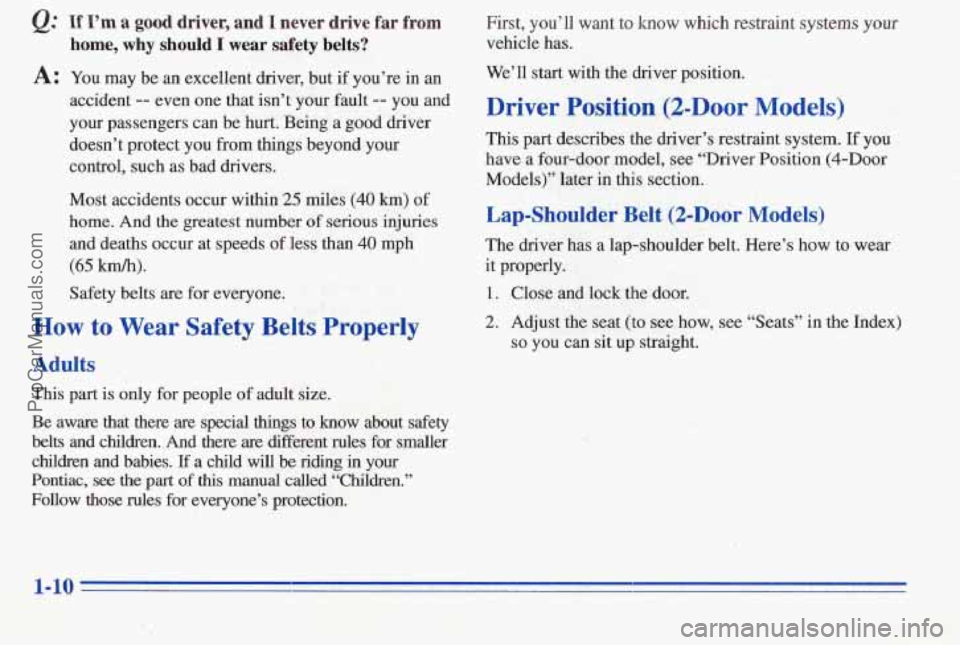
@ If I’m a good driver, and I never drive far from First, you’ll want to know which restraint systems your
home, why should I wear safety belts? vehicle has.
A: You may be an excellent driver, but if you’re in an
accident
-- even one that isn’t your fault -- you and
your passengers can be‘hurt. Being
a good driver
doesn’t protect you
fiom things beyond your
control, such as bad drivers.
Most accidents occur
within 25 miles (40 km) of
home. And
the greatest number of serious injuries
., , ;.:, =,. . and deaths occur at speeds of less than 40 mph 1- . -, .. - .. .- * :.I, (65 km/h). ,.: -. .. -8 , ,. . 6 ‘F:, - ,. . .I_ Safety belts are for everyone.
How to Wear Safety Belts Properly
Adults
This part is only for people o’f adult size.
Be aware that there are special things to know about safety
belts
and children., And there are different rules for smaller
children and babies.
If a child will be riding in your
Pontiac, see the part of this manud called “Children.”
Follow those rules for everyone’s protection. We’ll start with the driver position,
Driver Position (2-Door Models)
This part describes the driver’s restraint system. If you
have a four-door model, see “Driver Position
(4-Door
Models)” later i.n this. section.
Lap-Shoulder Belt (2-Door Models)
The driver has a lap-shoulder belt. Here’s how to wear
it properly.
1. Close and lock the door.
2. Adjust the seat (to see how, see “Seats” in the Index)
so you can sit up straight.
1-10
ProCarManuals.com
Page 59 of 370

6. Pull the rest of the shoulder belt all the way out of
the retractor to set the lock.
7. To tighten the belt, feed the shoulder belt back
into the retractor while
you push down on the
child restraint.
8. Push and pull the child restraint in different
directions to be sure it is secure.
To remove the child restraint, just unbuckle the vehicle’s
safety belt and let it
go back all the way. The safety belt
will move freely
again and be ready to work for an adult
or larger child passenger.
ProCarManuals.com
Page 72 of 370
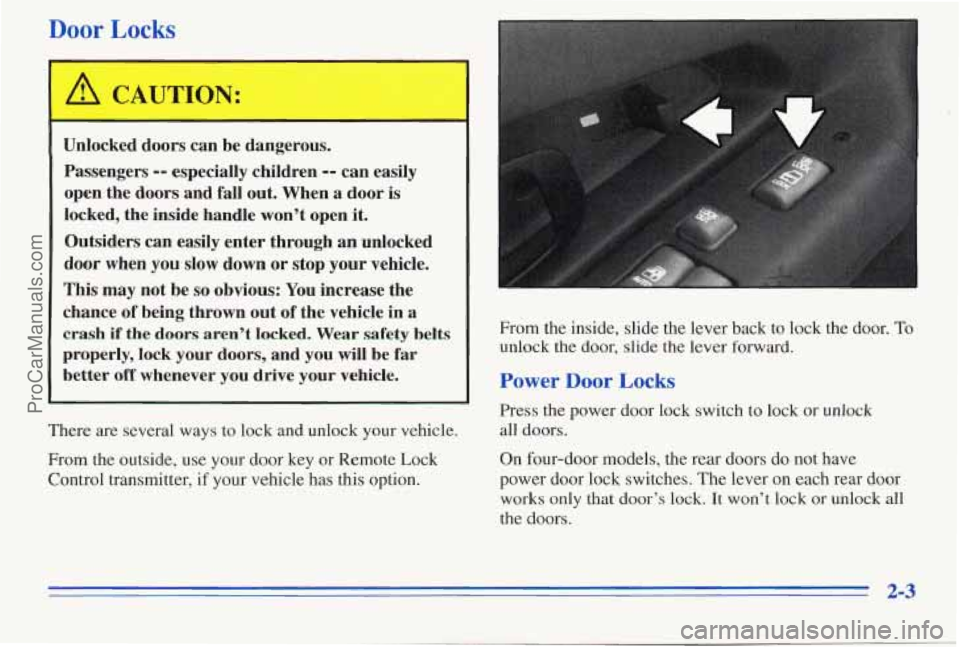
Door Locks
/1 CAUTION:
Unlocked doors can be dangerous.
Passengers
-- especially children -- can easily
open the doors and fall out. When a door is
locked, the inside handle won’t open it.
Outsiders can easily enter through an unlocked
door when you slow down
or stop your vehicle.
This may not be
so obvious: You increase the
chance
of being thrown out of the vehicle in a
crash if the doors aren’t locked. Wear safety belts
properly, lock your doors, and you
will be far
better
off whenever you drive your vehicle.
There are several ways to lock and unlock your vehicle.
From the outside, use your door key or Remote Lock
Control transmitter, if your vehicle has this option. From
the inside, slide the lever back to lock the door.
To
unlock the door, slide the lever forward.
Power Door Locks
Press the power door lock switch to lock or unlock
all doors.
On four-door models, the rear doors do not have
power door lock switches. The lever
on each rear door
works only that door’s lock. It won’t lock or unlock all
the doors.
ProCarManuals.com
Page 165 of 370
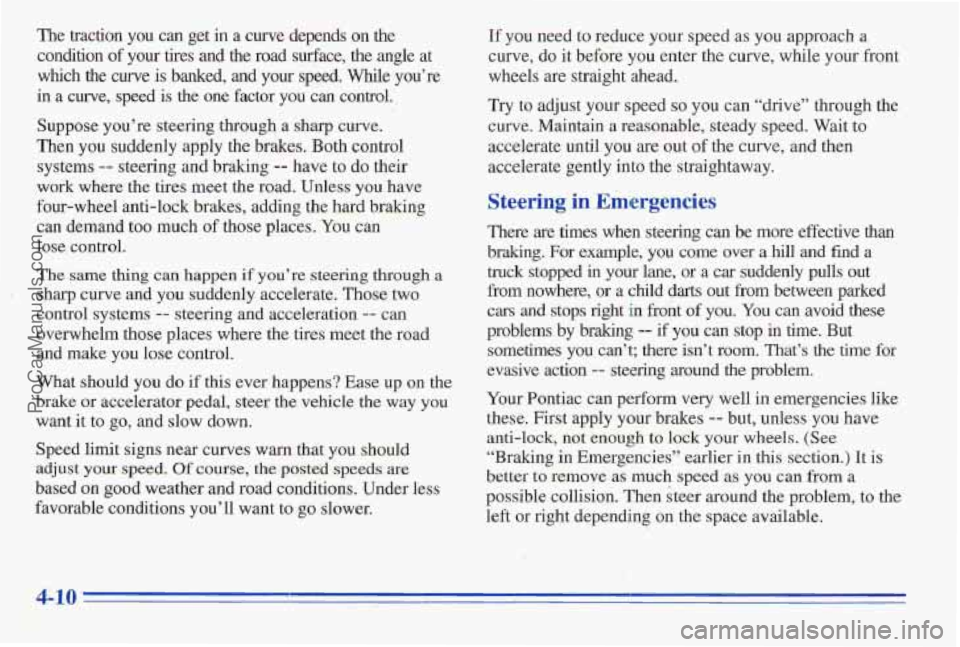
The traction you can get in a curve depends on the
condition of your tires and the road surface, the angle at
which
the curve is banked, and your speed. While you’re
in a curve, speed is the one factor you can control.
Suppose you’re steering through a sharp curve.
Then you suddenly apply the brakes. Both control
systems
-- steering and braking -- have to do ~eir
work where the tires meet
the road. Unless you have
four-wheel anti-lock brakes, adding
the hard braking
can demand too much of those places. You can
lose control.
The same thing can happen if you’re steering through a
sharp curve and you suddenly accelerate. Those two
control systems
-- steering and acceleration -- can
overwhelm
those places where the tires meet the road
and make you lose control.
What should you do
if this ever happens? Ease up on the
brake or accelerator pedal, steer the
vehicle the way you
want it to
go, and slow down.
Speed limit signs near curves warn that you should
adjust your
speed, Of course, the posted speeds are
based on good weather and road conditiolls. Under less
favorable conditions you’ll want to go slower.
If you need to reduce your speed as you approach a
curve, do it b’efore you enter the curve, while your front
wheels are straight ahead.
Try to adjust your speed so you can “drive” through the
curve. Maintain a reasonable, steady speed. Wait to
accelerate until you
are out of the curve, and then
accelerate gently into the straightaway.
Steering in Emergencies
There are times when steering can be more effective than
braking. For example, you come over
a hill and find a
truck stopped
in your lane, or a car suddenly pulls out
from nowhere, or a child darts out from between parked
cars and stops right in front of you. You can avoid these
problem
by braking -- if you can stop in time. But
sometimes you,can’t; there isn’t room. That’s the time for
evasive action
-- steering around the problem.
Your Pontiac can perform very well in emergencies like
these. First apply your brakes
-- but, unless you have
anti-lock, not enough
to lock your wheels. (See
“Braking in Emergencies” earlier in this section.) It
is
better t’o remove as much speed as you can from a
possible collision. Then steer around
the problem, to -the
left ‘or right depending on the space available.
I’ . , .I ,. ’ .~
.. . . ,.- , . . .. .
. .. :.
. . - I 1-.. -’ . ..
ProCarManuals.com
Page 361 of 370
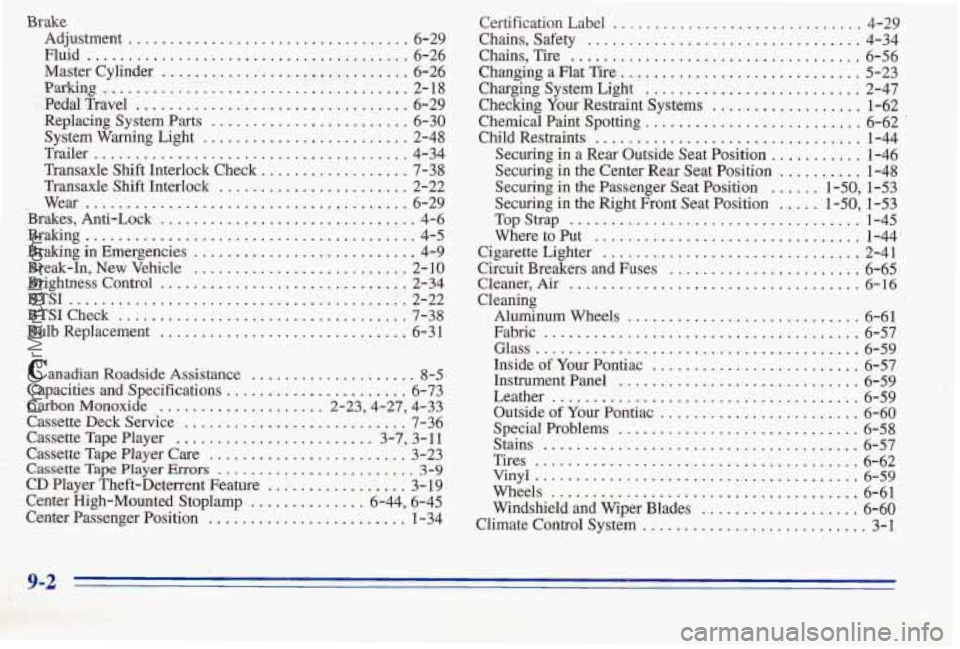
Brake
Adjustment .................................. 6-2 9
Fluid
......................................... 6-26
Master Cylinder
............................... 6-26
Paikhg ..................................... 2-18
Pedal Travel
................................. 6-29
'Replacing System Parts
........................ 6-30
System Warning Light
......................... 2-48
Trailer
...................................... 4-34
Transaxle Shift Interlock Check
.................. 7-38
Transaxle Shift Interlock
....................... 2-22
. Wear ..............................,........ 6-29
Braking
........................................ 4-5
Break-In. New Vehicle .......................... 2-10
Brightness Control
.............................. 2-34
Bulb Replacement .............................. 6-3 1
Brakes,Anti
-Lock
............................... 4-6
Braking in Emergencies ..................... ..... 4-9
BTSI .......................................... 2-22
BTSICheck
................................... 7-38
Canadian Roadside Assistance
.................... 8-5
Capacities and Specifications ...................... 6-73
Carbon Monoxide
.................... 2.23.4.27. 4.33
Cassette Deck SerGice ........................... 7-36
Cassette Tape Player
........................ 3.7. 3.11
Cassette Tape
Player Care ........................ 3-23
CD Player Theft-Deterrent Feature
................. 3- 19
Center Passenger
Position ........................ 1-34
Cassette Tape Player Fxr~rs .......... .. ...... 3-9
Center High-Mounted Stoplamp .............. 6-44. 6-45 Certification Label
.............................. 4-29
Chains. Safety ................................. 4-34
Chains. Tire ................................... 6-56
Charging System Light
.......................... 2-47
Checking Your Restraint Systems
.................. 1-62
Chemical
Pahit Spotting ................. ' ......... 6-62 .
Child Restraints ................................ 1-44
Securing in a Rear Outside Seat Position
........... 1-46
Securing in the Center Rear Seat Position
.......... 1-48
Changing
a Flat Tire ............................. 5-23
Securing
in the Passenger Seat Positilon ...... 1-50. 1-53
Securing in the Right Front Seat Position
..... 1-50. 1-53
TopStrap
................................... l-45
Where to Put ................................ 1-44'
Cigarette Lighter
.................. ......... 2-41
Circuit Breakers and
Fuses ....................... 6-65
Cleaner. Air ................................... 6-16
Cleaning Aluminum Wheels
.......................... 6-61
. Fabric .......................... ......... 6-57
Glass
....................................... 6-59
InsideofYourPontiac
......................... 6-57
InstrumentPanel
............................. 6-59
Leather ...................................... 6-59
Outside
of Your Pontiac ......................... 6-60
Stains ...................................... 6-57
Tires
....................................... 6-62
Wheels
..................................... 6-61
Climate Control System
............................ 3-1
Special Problems ............................. 6-58
Vinyl ....................................... 6-59
Windshield and Wiper Blades ................... 6-60
9-2
ProCarManuals.com
Page 366 of 370
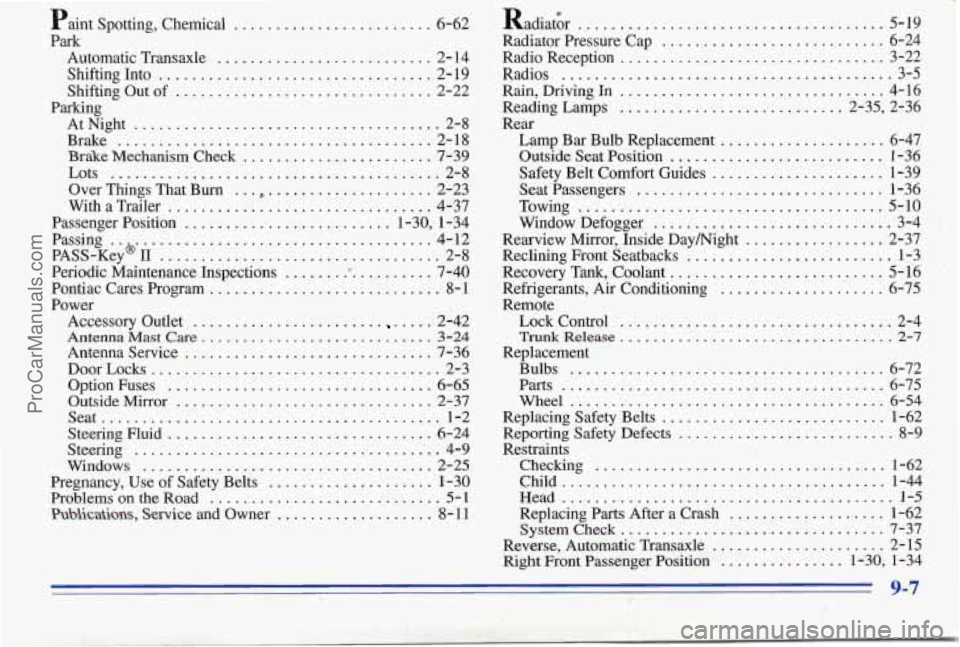
Paint Spotting. Chemical .... ... 6-62
Park
Automatic Transaxle
.......................... 2- 14
Shifting Into
................................. 2- 19
Shifting Out of
............................. 2-22
AtNight
..................................... 2-8
Brake
...................................... 2-18
Brake Mechanism Check
....................... 7-39
Lots
........................................ 2-8
Over Things That
Bum ........................ 2-23
With a Trailer ................................. 4-37
Passenger Position
......................... 1-30. 1-34
Passing 4-12
PASS-Key
II .................................. 2-8
Periodic Maintenance Inspections ................... 7-40
Pontiac Cares Program ............................ 8-1
Power
..... FJ.
Parking
......... ....... .......... ...... Accessory Outlet ..- ...... 0: ... ;. y i. .; . * J;? . ....... . !. ... ..w 'X . 2-42 ........
Antenna Mast Care ............................ 3-24
Antenna Service .............................. 7-36
DoorLoc
ks ................................... 2-3
Option Fuses
................................ 6-65
Outside Mirror
............................... 2-37
Seat
......................................... 1-2
Steering Fluid
................................ 6-24
Steering ..................................... 4-9
Windows
................................... 2-25
Pregnancy. Use of Safety Belts
.................... 1-30
Problems
on the Road ............................ 5-1
Publications. Service and 'Owner ................... 8- 11
T
RadiaGr .............. ......... 5-19
Radiator Pressure Cap
........................... 6-24
Radio Reception
................................ 3-22
Radios
........................................ 3-5
Rain. Driving
In ................................ 4-16
Reading Lamps
................ . . 2.35. 2.36
Rear
Lamp
Bar Bulb Replacement .................... 6-47
Outside Seat Position
.......................... 1-36
Safety Belt Comfort Guides ..................... 1-39
Seat Passengers
.............................. 1-36
Window Defogger
............................. 3-4
Rearview Mirror. Inside Daymight
................. 2-37
Reclining Front Seatbacks
......................... 1-3
Recovery Tank. Coolant
.......................... 5-16
Refrigerants. Air Conditioning
.................... 6-75
Remote Lock Control
................................. 2-4
Trunk Release ................................. 2-7
Towing ..................................... 5-10
Replacement Bulbs
...................................... 6-72
Parts ....................................... 6-75
Wheel
...................................... 6-54
Replacing Safety Belts ........................... 1-62
Reporting Safety Defects
.......................... 8-9
Restraints
Checking
................................... 1-62
Child
....................................... 1-44
Head ......................................... 1-5
Replacing Parts After a Crash .................... 1-62
Systemcheck
................................ 7-37
Reverse. Automatic Transaxle
..................... 2-15
Right Front Passenger Position
....... .. ....... 1-30. 1-34
9-7
ProCarManuals.com